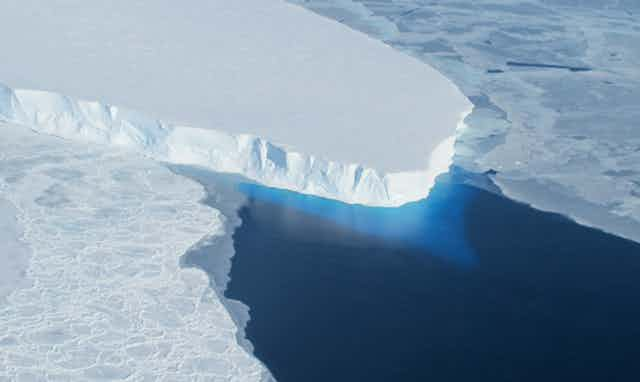Antarctic climate science is having a moment – a worrying moment. Three new studies have all concluded that the West Antarctic Ice Sheet has begun to collapse. This collapse will impact humanity for generations to come, and the indications are that it is too late to stop it.
Satellite measurements compiled by UK researchers have shown that Antarctica is losing 160 billion tonnes of ice per year, mainly through thinning of West Antarctica’s ice sheets.

Meanwhile, a NASA-linked study has found that major West Antarctic glaciers have retreated by several kilometres over the past two decades, and researchers at the University of Washington found that one of these, the Thwaites Glacier, is set to collapse over the coming centuries, potentially triggering 3 metres of sea level rise.
The potential collapse of West Antarctica’s ice sheets is not just a problem for Antarctica. It will dramatically change coastlines all over the world.

The ‘climate gorilla’
Several years ago, at a science forum in Canberra, we were encouraged to imagine a “greenhouse future”. I identified the West Antarctic Ice Sheet as the 800-pound gorilla hiding in the climate closet. Why? The ends of many of the glaciers that drain this ice sheet are already significantly below sea level, and the ice sheet is not hemmed in by mountains, as Greenland’s ice sheets are.
The combination of rising sea level and the warming Southern Ocean will release the ice sheet from its grounding line – the NASA study has already found that the glaciers’ grounding lines are in rapid retreat. Without an anchor on land, the ice sheets’ collapse is inevitable and cannot be slowed.
The total collapse of the vulnerable parts of West Antarctica’s ice sheets would raise sea levels by at least 3 metres. The possibility of this happening has now moved from the hypothetical to an unfortunate reality. The best we can now hope for is that this collapse will be slow and stately, and take centuries to unfold.
If this is the case, then civilizations can probably adapt to the havoc this will cause to coastal communities. However, we have evidence from prehistoric warm periods that this could occur over decades. At this point we don’t know long it will take, but we do know that the climate forcing today is much stronger than at any time in over 50 million years.
Given we have made so little progress on limiting our global carbon emissions, the odds are that ice-sheet collapse will only accelerate. Those of us who study climate history are confident that once this sort of collapse begins, it will not stop.
The celebrated US climatologist Wally Broecker often talks about the idea that we are playing Russian Roulette with the climate. In West Antarctica, we have just loaded another barrel. With apologies to Clint Eastwood, are we feeling lucky?
If not, then we are witnessing the beginning of the destruction of trillions of dollars’ worth of coastal infrastructure.
Lighting the fuse
You can be sure that the insurance industry is paying attention. How long will it be before property less than 5 metres above sea level is uninsurable? I hope it is a long time, but we will all be watching very closely how fast the West Antarctic Ice Sheet collapse accelerates.
The US glaciologist Richard Alley told the New York Times that “if we have indeed lit the fuse on West Antarctica, it’s very hard to imagine putting the fuse out”.
Another way of putting it is that we appear to have crossed a tipping point. As Alley also pointed out, there are many other fuses that could be lit, and probably will be, if the collapse markedly accelerates - and these would add to the rate and magnitude of the sea level rise.
One of those potential fuses is the Totten Glacier, on the margin of the East Antarctic Ice Sheet. In this area, a rift in the Antarctic crust allows sea water to extend hundreds of kilometres under the ice, literally undermining the ice.
I am involved with a joint Australian-American project that will investigate this area’s past and future vulnerability to rising seas and warmer waters.
While we scramble to work out what is happening to the frozen continent, the signs are that it is changing before our eyes, and changing rapidly.

